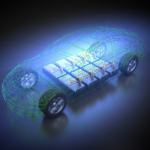New battery concept “Light Battery” – modular, safe and wireless
05.06.2018
A powerful, reliable and safe energy storage system can improve trust in electric vehicles (EVs). To overcome the limitations of traditional battery systems, LION Smart has developed a proprietary new battery concept. This new development will raise the bar due to the absence of internal cabling and a highly sophisticated safety concept.
The ongoing discussions about sectoral bans of vehicles with combustion engines accelerate the development of new EVs. But one reason that stops potential customers buying these EVs is often the short driving range. Moreover, there are reservations about their reliability and safety. Therefore, many potentially interested drivers are reacting more conservatively about driving electric vehicles. Vehicles with conventional combustion engines are subject to the same safety standards as EVs but there are concerns about new technologies which must be taken seriously. However, these concerns can be refuted by effective new concepts.
Light Battery overcomes limitations
LION Smart GmbH took the challenge to ask itself the key questions to develop a proprietary new battery concept which exactly addresses the mentioned reservations. A modified BMW i3s which has a driving range of more than 700 km serves as a concept study – compared to the original car this represents a more than doubled driving range. The long-term experience from various prototype projects shows that most traditional battery concepts have their own different restrictions. This starts with unfavorable geometric dimensions up to a high manual effort for assembly. To solve these problems and more with innovative concepts as a goal, the development of the modular design of the Light Battery started.
Technical and economic challenges
There are various possibilities to optimize the battery in the design stage. With regard to technical aspects of particular importance are: high energy densities, robust safety concepts and longevity, but in focus there are also economic criteria like costs of material and assembly. There are many new technical solutions integrated into the Light-Battery concept which in addition saves manufacturing costs. The modular design of the new battery combined with the high functional integration of the components used results in a very high energy density. The cable-less internal construction of the battery allows a cost-effective and nearly fully automated production.
Flexible and modular design
The smallest module of the new battery-pack is the so-called Supercell. It consists of a housing in which cylindrical battery cells are arranged hexagonally and connected in parallel. The Supercell can be adapted to different battery cell formats like 18650, 21700 etc. and due to its high scalable degree of parallelization provides the possibility to be adapted to the most diverse of customer requirements. Several Supercells are plugged together in a modular structure to build a module. This enables the creation of batteries for underbody installation in vehicles as well as in other complex mounting spaces. Every Supercell features a measurement card which monitors the voltage and temperature of the cell.
The measurement card is connected to the battery poles of the Supercell and thus powered. This completely eliminates the complex sensor wiring. The LIRS (LION Infrared Slave) measurement cards developed by LION Smart can be cascaded in a master-slave arrangement and carry out wireless data transmission via an infrared interface. In the same way the LIRS card communicates bidirectionally with the LCM master (LION Control Module).
Optical data transfer
Infrared interfaces enable data rates up to some Gbps and realize system monitoring with high resolution and fast sampling rates. Because there are no cables needed the data transmission is not sensitive to electromagnetic radiation and is robust against mechanical stress. Since there is no sensor wiring short circuits due to defective sensor wires are avoided and the LCM as well as the individual LIRS are safely galvanically isolated from each other. The modular optical data transmission can be arranged very flexible and costly work steps like cable connection, installing cable canals and complex attaching or joining processes are eliminated completely. Therefore, the Light Battery raises the bar regarding automated manufacturing processes. The battery management system (BMS), as a distributed system, integrates seamlessly into the battery system because it is part of the Supercell except for the LCM.
Well cooled and protected
In the thermal management system of the Light Battery the High-Tech-Fluid Novec from 3M is used. It is a dielectric liquid which is already in use in some high-performance applications and for cooling of servers. Due to the fact that the operating temperature in the battery system has considerable impact on the aging process and the power output of the individual battery cells it is absolutely necessary to cool the cells effectively and homogenously. To regulate the optimal operating temperature of the cells in the Light Battery they are directly immersed in the coolant. The very large surface of the round cell and the direct thermal coupling with the coolant results in a very good heat transfer. The symmetrical coolant flow enables a homogenous volumetric flow rate of the fluid and results in a uniform temperature in all battery cells. The coolant serves not only for cooling reasons but is also an integral part of the safety concept of the battery.
Tolerate defect individual battery cells
The quality of a battery system, let´s say its capacity and usable energy, is defined by the quality of its weakest individual cell. If the system architecture is based on large cells were only a few or no parallel connected cells are included, the quality of the individual cell becomes immensely important. If there is only one weak cell in the system the performance of the entire system is limited. Consequently, it must be strived to achieve a maximum homogeneity of the connected battery cells. The Light Battery achieves this by using many parallel connected round battery cells.
In the case of an internal failure of an individual battery cell during its life time, e.g. a short, a protective fuse disconnects the failed cell from the system. This fuse is integrated into the cell connection and duplicated for every single cell. After disconnecting the cell, it is no longer an active part of the battery system and the remaining system is still fully operational.
Preventing fire in battery cells effectively
The redundant fuses of the individual cells in the Light Battery enable a very high level of system safety. In the case of a thermal runaway the cooling is concentrated via an alternative cooling path to the affected battery cell to cool it down as effectively as possible and contain the reaction. The phase change of the coolant from liquid to gaseous state takes a lot of energy from the burning cell and avoids inflammation of adjacent cells (propagation). In the case of phase change the releasing gases can escape via a valve.
High energy density via functional integration
The thermal management of the Light Battery especially proves the consistent high functional integration of this device. For example, the coolant has three different functions: cell cooling, fire extinguisher and data transfer. Another example is the contact plate of the round cells. It connects the cells in a parallel arrangement, includes the fuses for protection against shorts, replaces the sensor wiring, and ensures power for the LIRS. The integral design and high functional integration of the individual components enables the optimal utilization of the installation space. The battery construction includes fewer components; it makes the manufacturing processes more efficient, and allows a high degree of automation. Moreover, the costs of materials and manufacturing can be reduced, appropriately.
Large driving ranges, high safety, low costs, longevity and high-performance will help to improve acceptance of electro mobility. The first realization of the Light Battery concept will prove this with a capacity of 94 kWh – this corresponds to a driving range of 700 km – installed in the unmodified installation space of a BMW i3.
You´ll find the article in German language and associated pictures under:
https://www.all-electronics.de/batteriekonzept-light-battery/
This article is already published in emobility tec, the technical magazine for hybrid vehicles and electromobility.



